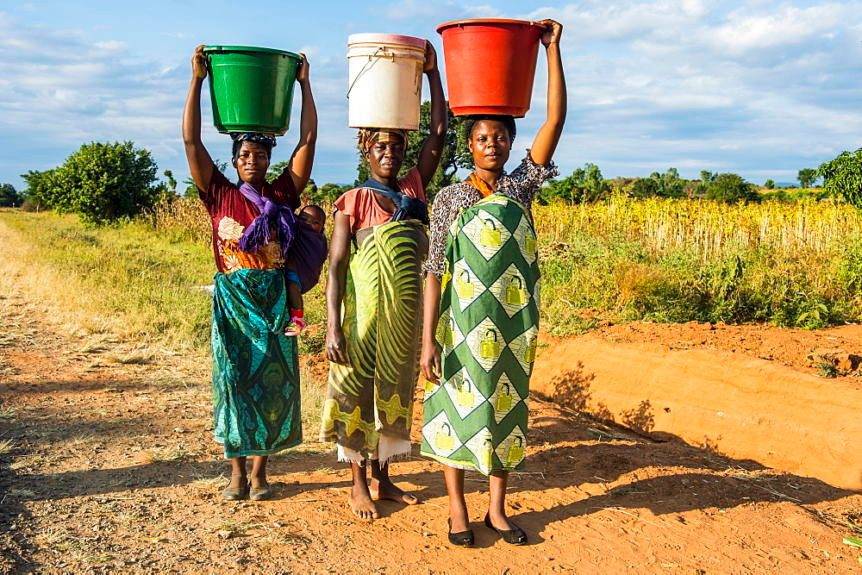How A Girls School In Rural Kenya Is Drawing Clean Water From Thin Air

Growing up in Nothern Kenya where it is mostly arid is such a hard life as people living in the rural communities in the region have to travel long distances in search of water. And these long, arduous trips are not always fruitful. It gets even worse during those long dry spells as many people are forced to walk even farther distances in search of this basic necessity that should ordinarily be a bare essential.
In these communities, it is not uncommon for young girls to shoulder the responsibility of helping their parents look after their younger siblings and take care of house chores from a very young age. And because of this, coupled with the squalor and privations in these communities, many of them get drawn away from school and into early marriages – truncating their academic pursuits.
A girls’ community center, where 1,200 of such girls have been rescued from early marriage and female genital mutilation, is using a novel technology to enjoy fresh water drawn from air using different solar panels that many regular folks in the capital, Nairobi; some 340 kilometers away, have never ever seen.
The center run by the Samburu Girls Foundation in Loosuk is using hydro panels technology installed by an American company called Zero Mass Water which pulls water vapor from the air, then condenses it into a reservoir. With 40 of such hydro panels working in tandem, over 400 liters of water is drawn from the air per day, which is quite sufficient for the needs of the girls and also sees to it that they live comfortably. The time and energy that would have been expended by the girls walking several miles to fetch water and inadvertently courting unwanted attention from child bride seekers are now well-spent learning important skills and participating in meaningful academic activities.
Interestingly, this eco-friendly innovation not only provides much-needed clean water but also saves the environment from degradation as trees would have ordinarily been cut down and the wood used as fuel to boil the water that would be otherwise too dangerous to drink before boiling.
Zero Mass which is a startup based in Arizona in the United States is perfecting the science of turning sunlight and air into clean water without the use of electricity. The panels get placed in areas that provide the greatest sunlight exposure whether on the ground or even on the roofs of houses. In more relatable terms, the process mimics how dew gets formed on the leaves of plants as is observed in the early hours of the day. The amount of water that can be produced is limited by the amount of humidity in the atmosphere as well as the amount of solar energy available for the conversion of moisture in the atmosphere into substantial amounts of water that can be used for domestic use. The features on the circuit board of the hydro panels are set up to maximize water output with each panel deployed, and tabs are kept on the production using a large screen at the company headquarters in Arizona. Each of the panel units costs around USD 1.5 K.
Girl drawing water from solar-powered panes in Loosuk in Samburu – Image courtesy of VOAnews
In a conversation with the World Economic Forum, Cody Friesen, CEO and Founder of Zero Mass Water, described the company’s collaboration with the Samburu Girls Foundation on the project as an example of its efforts to make sure the technology “is accessible to people across the socio-economic spectrum.” Zero Mass Water, the proprietors of this technology, is reported to have also sold or donated the panels in 16 countries, including South Africa.
George Sirro, a solar engineer with Solatrend Ltd.; a Nairobi-based solar equipment company, said such devices could be a huge help not only to people but also in curbing deforestation which is known to be one of the drivers of climate change and the worsening drought in Kenya.
Even in urban centers, clean and safe drinking water remains a challenge. Growth in human population has caused a strain in access to water. Change in weather pattern also contributes to this, especially as human activity and rapid urbanization have led to the felling of trees to make room for settlements. This is known to interfere with water catchment areas.
In urban centers, water supply is a booming business as water supply companies and vendors make substantial income supplying a resource that is, ironically, the most abundant on the planet – a paradoxical case of ‘water everywhere and yet none to drink or use’. Rural communities are even worse off in this regard as they don’t have the option of accessing the vendors who supply the water for a fee. Thus, clean and potable drinking water is anything but easily available in remote and far-flung corners of the country.
Trekking as far as five kilometers to the waterfront and back each day, as well as carrying jerricans of water, takes up a lot of time and effort that could have gone into other productive activities. In arid areas that are known to experience extended sunny, dry spells, leveraging solar technology which is usually associated with power and heating for a new application which involves providing safe water for many social classes is undoubtedly a welcome development. And true to this, community members in Samburu who have seen how the panels work at the school are already eager to gather funds to get some of the panels for themselves.
Feature image credit: robertharding.com